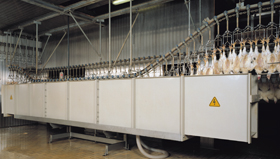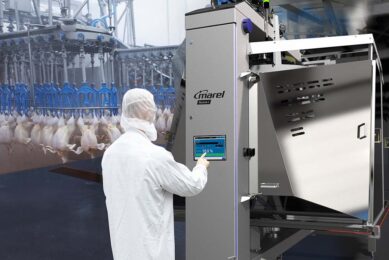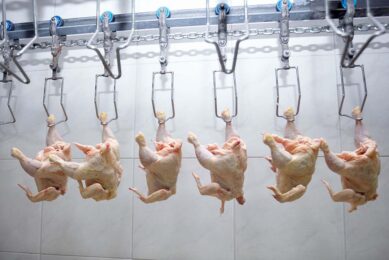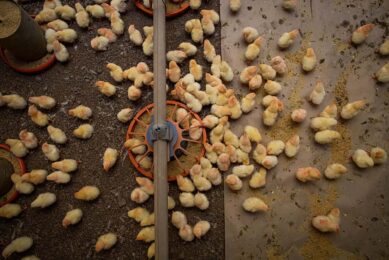Saving water in the processing plant

Many poultry processing operations around the world are often using huge quantities of usually scarcely available water. By taking smart steps, this can be reduced substantially. As a result, this will lead to saving valuable water and less expenses.
By Fabio Nunes, poultry processing consultant, Curitiba, PR, Brazil
On April 12, 1961, from the small spaceship Vostok-1 which gravitated at an altitude of 302 km around the globe, Russian Yuri Gagarin, the first human astronaut, exclaimed “The earth is blue!”. The blue colour that enchanted the young astronaut was the colossal mass of water that covers some 70% of the earth’s surface and accounts for a net volume of approximately 1.5 billion of cubic kilometers. This huge amount of water on the surface of the planet is fixed, with the form and location varying over space and time: saltwater in oceans, freshwater in glaciers, water in the atmosphere, etc. However, just 2.5% of this huge volume is suitable for human consumption and for use in agricultural production (Figure 1).
Humans have little or no control over most of this water. Most investment concentrates on water in rivers and lakes, but soil moisture and groundwater, together, account for 98% of the world’s available freshwater. Many people worry about how much drinking water is available, not realising that agriculture dominates human water use. According to UNESCO, presently 67-68% of all water withdrawn for human use, on a global basis, is soaked up by agriculture, mostly in the form of irrigation. Industry accounts for 23% and domestic use as drinking water and for sanitation accounts for about 8% of the total consumption. Each day, a person drinks 2 to 4 litres of water, but eats food that requires 2,000 to 5,000 l of water in its production. These averages mask considerable variation.
Broiler least demanding
These global averages vary a great deal across regions and continents. In Africa the agricultural use of water sucks away 88% of all water withdrawn for human use, domestic and industry accounts, respectively, for 7% and 5% only, and in the EU 54% of the water available is used in industry, while agriculture and domestic use account for 33% and 13% of the total use, respectively.
These global averages vary a great deal across regions and continents. In Africa the agricultural use of water sucks away 88% of all water withdrawn for human use, domestic and industry accounts, respectively, for 7% and 5% only, and in the EU 54% of the water available is used in industry, while agriculture and domestic use account for 33% and 13% of the total use, respectively.
Among the protein animal production chains, broiler production is the least-water user, demanding 3,900 litres to produce 1 kilogram of meat, while beef demands 15,500 l/kg and pork 4,900 l/kg. Water is a key-player throughout the entire poultry production chain, being of vital importance from farm to plant. In the plant the importance of the water is significant, as it is used to cool birds down while on the holding shed, to secure the high-level standard of hygiene demanded by the products, installations, work clothing, personnel and utensils; to carry over the process’ by-products and debris; to improve the processing yield and, last but not least, to quench the workers thirst!
Three step operation
The source of water used in poultry processing plants varies among countries. It can be either supplied by the municipality, or outsourced from underground by means of artesian wells, the commonest and cheaper source throughout Latin America as a whole, Brazil included.
The source of water used in poultry processing plants varies among countries. It can be either supplied by the municipality, or outsourced from underground by means of artesian wells, the commonest and cheaper source throughout Latin America as a whole, Brazil included.
The sanitary requirement to wash and disinfect trucks and crates prior to travelling back to the farms, which is mandatory in some countries, while just customary in some others, makes this three-step operation – immersion in water for solid material loosening, high-pressure foaming/washing and high-pressure rinsing, the heaviest water user in the area. In opposition to the water single-usage cycle of the old washers, the modern ones have been designed to move crates and water in counter-flow, making use of the water in a saving multi-usage cycle. However, as older generations of equipment still predominate, water consumption in this area of the plant will be high for a longer period of time.
Replenishing stunning tubs
The majority of broilers are still stunned electrically, which hardly depend on water to work. Although relatively small, the demand by the stunner is continuous as the tub level must be continuously replenished to replace the water broilers carry over while travelling through.
The majority of broilers are still stunned electrically, which hardly depend on water to work. Although relatively small, the demand by the stunner is continuous as the tub level must be continuously replenished to replace the water broilers carry over while travelling through.
To keep the live reception clean, companies should think of alternative solutions to the common “water broom”, which is often negligently and wastefully used. Dirt from crates can be accumulated underneath the transportation belt, either contained on the floor by bumps built along side the transportation belt or onto a suspended tray. Any other minor solid debris can be swept away by using rakes. Never clean, but recycled water instead – from the chilling line, the lungs vacuum pumps, rain accumulation tanks and others – is the suggestion to wash the area down when necessary.
Large scalding tanks
The commercial failure of hot-air scalding dismisses, apparently forever, the dream to scald birds using just 50 ml of water per carcass, among some other great benefits the system claimed to offer. So, the industry continues to be dependent on the heavy-weight water users of conventional scalding tanks. The massive water consumption of this process derives from the old, mammoth sized tanks still largely present in the plants, from the need to comply with the sanitary regulations in force in some countries which requires the tank to be fully drained and refilled a number of times a day and the tank water replenished throughout the working hours, and from the wasteful management of the process in some others, as well.
The commercial failure of hot-air scalding dismisses, apparently forever, the dream to scald birds using just 50 ml of water per carcass, among some other great benefits the system claimed to offer. So, the industry continues to be dependent on the heavy-weight water users of conventional scalding tanks. The massive water consumption of this process derives from the old, mammoth sized tanks still largely present in the plants, from the need to comply with the sanitary regulations in force in some countries which requires the tank to be fully drained and refilled a number of times a day and the tank water replenished throughout the working hours, and from the wasteful management of the process in some others, as well.
Scalding tanks of 50,000 litres volume are still very common industry wide. So, in a plant scalding 10,000 bph for 16h/day, for 25 days/month and 12 months/year in a tank like that and required to drain down and refill the tank just once a day, the consumption of water to accomplish this requirement reaches 30 million litres annually. Furthermore, to comply with the additional fresh make-up water requirement of 0.5 litre/carcass/h, an extra 24 million litres of water are consumed annually, totalling, in the tank only, 54 million litres of water annually.
The subsequent three pluckers defeathering line demanding some 0.5 l of water per bird, accounts for an extra consumption of 24 million litres of water annually. In total, the scalding and plucking department only, accounts for a consumption of 78 million litres of water annually. Giving a person needs 104 litre of water a day, as per the WHO recommendations, that consumption equates to a city of 750,000 inhabitants.
Setting a standard
In plants that operate under either loose or inexistent sanitary requirements, the annual water consumption in the scalding and plucking processes, as a whole, may oscillate either up or down dramatically. When this is the case, it would be smart to first measure how much water is currently used, by simply installing a hydrometer to the main fresh water line, and further, setting a standard for future consumption in each piece of equipment, according to any national or international reference.
Broiler carcasses go through an outside washer to have their outer physical contaminants washed off before moving from the scalding and plucking room, a ‘dirty area’, over to the evisceration room, a ‘clean area’. In countries where this requirement is mandatory, the washer is set by the sanitary authorities to spray, in general, 1 l of clean water/carcass, and the flow is monitored by means of a hydrometer.
Such a flow under the previous operational parameters means 48 million litres of water annually. There is not much that companies can do in this case to reduce the consumption, expecting that researches that may lead to higher efficacy of on-line chemical interventions in parallel with improvements in the washer design and functioning contribute to make the equipment more water-saving. Where not mandatory, the water flow in the washers varies from a mist, which barely touches the carcass, through a heavy shower, so set without either control or criteria, creating some good opportunities for water saving. Likely in the scalding and plucking department, to reduce the water wastage associated with this job, companies are advised to install a hydrometer on the water line to, first, learn the present consumption, further, setting a standard flow, and further implementing a water monitoring program.
Seven machines setup
The pressure posed by environmental issues and the costs of water in-flow and out-flow treatments are behind the substantial reduction in the water consumption by the evisceration lines achieved thanks to the incorporation of high pressure, low consumption nozzles and CIP fixtures to the machines.
The pressure posed by environmental issues and the costs of water in-flow and out-flow treatments are behind the substantial reduction in the water consumption by the evisceration lines achieved thanks to the incorporation of high pressure, low consumption nozzles and CIP fixtures to the machines.
The per machine consumption goes from as low as 0.5 m3/h in the opening machine, crop machine and neck breaker, till 1 m3/h in the vent cutter, 1.1 m3/h in the I/O washer to as high as 2.5 m3/h in the eviscerator. In the final inspection machine the consumption is neglectable. As the usual line setup embraces seven machines, the average consumption reaches 1 m3/h, meaning, for the aforementioned plant, 0.1 litre/carcass or 4.8 million litres annually, a small fraction of the scalding and plucking demand. This is huge progress.
Of course this low consumption may easily escalate influenced by the need dictated by the off-line reprocessing of contaminated carcasses. This procedure, acceptable in US, but not in Brazil, where contaminated carcasses are salvaged, demands a lot of water for the thorough washing of faecal-contaminated carcasses prior to hanging them back on the shackles.
Educate plant personnel
Manual plants may present a more attractive set of opportunities for water saving. One should first target the potential offered by the “swan-neck” hand-washers. Available for every two employees they are customarily locked up, providing a continuous water flow, and not knee- or foot-triggered when necessary.
Manual plants may present a more attractive set of opportunities for water saving. One should first target the potential offered by the “swan-neck” hand-washers. Available for every two employees they are customarily locked up, providing a continuous water flow, and not knee- or foot-triggered when necessary.
To eviscerate manually 10,000 bph, a plant needs some 48 people and 24 “goose neck” hand-washers. Assuming as 1cm the diameter of each hand-washer pipe and an atmospheric water pressure, the wasted water flow rate will reach 5 l/minute each, or 120 l/minute in total, which means 34.5 million litres of water annually. Last but not least, educate plant personnel to close all the water faucets during meal brakes.
Huge water amounts
To safeguard the products’ safety, carcasses must have their temperature quickly reduced after evisceration. For so, plants can use either evaporative air chilling, which uses a minimal amount of water and whose usage is circumscribed mostly to EU, or water chilling, which demands huge amounts of water and is widely diffused over the industry.
To safeguard the products’ safety, carcasses must have their temperature quickly reduced after evisceration. For so, plants can use either evaporative air chilling, which uses a minimal amount of water and whose usage is circumscribed mostly to EU, or water chilling, which demands huge amounts of water and is widely diffused over the industry.
A chilling line to cool down 10,000 bph is usually setup with one pre-chiller and a chiller. To fill them, up 325,000 litres of water are needed and to operate them 1.5 l/carcass and 1.0 l/carcass are to be added in the pre- and chiller, respectively, which means the global daily consumption of water goes as high as 400,000 litres, which is equivalent to 120 million litres of water annually.
Reuse water masses
The water saving potential of recycling technology for chilling line water is huge, but still experimental. Regrettably processors devote little to no attention to search for means to re-use this huge mass of water. Pre-chiller water has the potential to flush away first the evisceration line offal and then the feathers.
The water saving potential of recycling technology for chilling line water is huge, but still experimental. Regrettably processors devote little to no attention to search for means to re-use this huge mass of water. Pre-chiller water has the potential to flush away first the evisceration line offal and then the feathers.
This double usage of the water not just prevents clean water from being used, but likely helps retaining fat and particulate material suspended in the woven feathers in the water, thus reducing the load into the waste-water treatment. On the other hand, the chiller water overflow at 4°C and 7°C has the potential to be coarse-filtered and re-used as a cooling media in a heat-exchanger. Out from the heat-exchanger it can be further re-used in the evisceration trough, to wash the live-hauling trucks down, for floor cleaning, etc. (Table 1).
Water conservation programs
Experience shows that despite water usage in poultry plants varying across countries and companies, it has little to do with environment consciousness and mostly to do with water scarcity; environmental regulations and the cost of water supply and discharge, the ultimate variables that, in fact, determine either countries or companies’ ‘consciousness’ about water usage management.
Experience shows that despite water usage in poultry plants varying across countries and companies, it has little to do with environment consciousness and mostly to do with water scarcity; environmental regulations and the cost of water supply and discharge, the ultimate variables that, in fact, determine either countries or companies’ ‘consciousness’ about water usage management.
Where those concerns aren’t in place, plants usually don’t rank water usage as a top priority. Supporting this statement is the fact that despite many of them listing water usage among their operational parameters of concern, often little or no attention is devoted to implementing an efficacious water conservation program. Water conservation programs pay!
Join 31,000+ subscribers
Subscribe to our newsletter to stay updated about all the need-to-know content in the poultry sector, three times a week. Beheer
Beheer








 WP Admin
WP Admin  Bewerk bericht
Bewerk bericht